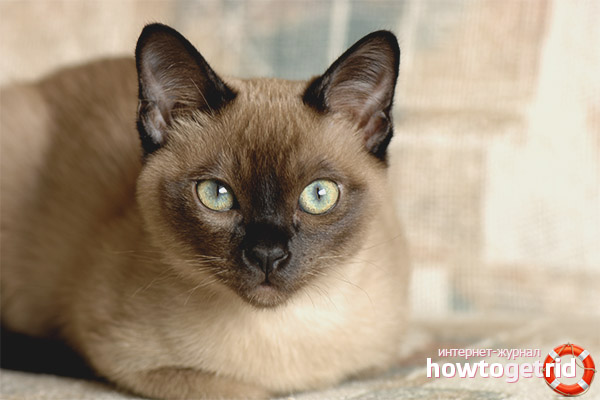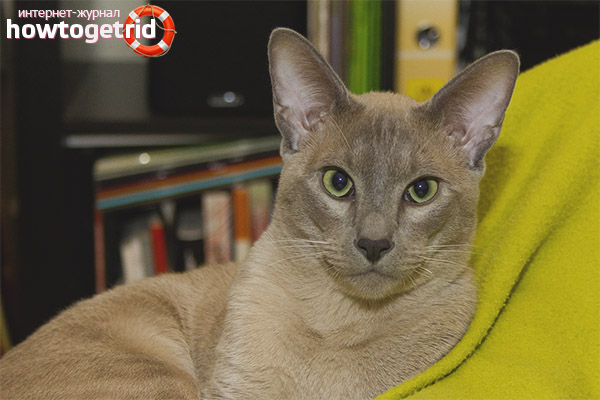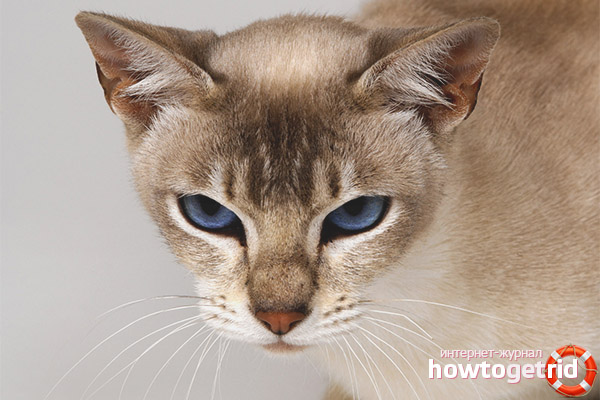The content of the article
Tonkin cats or tonkinesis are the result of crossing Siamese and Burmese breeds. The main feature of the breed is aquamarine eyes. In addition, as a result of selection, the tonkinesis received the best features from the above-mentioned ancestors. For many years this beautiful animal has been one of the most sought-after animals around the globe.
The story of the appearance of Tonkin cats
For the first time they became known from the works of Siamese literature from the 14th to the 18th century. At the beginning of the 19th century, "chocolate Siamese", as they were then called, were brought to the territory of England. A cat named Wong Mau, introduced to the United States by Dr. Joseph Thompson in the 30s of the twentieth century, became the first in this country.
Canada is considered to be the official homeland of the tonkinesis. It was on this territory that the main program for cross-breeding between Siamese and Burmese was implemented.
The beginning of the history of Tonkinesis was laid by the owner of a shy Burmese cat - Canadian breeder M. Conroy. Her cat did not allow cavaliers of her breed. But she liked the Siamese. After mating, burnt babies were born with a tinted color and with aquamarine eyes. These kittens were subsequently mated to Wong Mau.
Description
Tonkinesis - medium sized cats. The weight of the female is from 3 to 4 kilograms, and the cat is from 4 to 6.
Tonkin cat standards according to TICA:
- Head. It has medium dimensions in relation to the body. In width, less than in length. Wedge-shaped. Together with the ears it has the shape of an isosceles triangle with high and neat cheekbones.
- Torso. Rectangular in shape with an average length and size, a rounded chest of medium width. The vertical spine has an elevation towards the hind legs. The body is muscular. The stomach is flat.
- Hairline. The coat is of medium length, adheres to the body, the cover is distinguished by its special softness and silkiness.
- Limbs. Proportional in length to body. Refined and slender. Front shorter than the rear. Paws with oval pads.
- The ears. Medium in size with a wide base. They have an elongated shape. Rounded at the ends with a slight slope towards the nose.
- Eyes. Almond shaped. Medium size. Form an angle with respect to the outer edge of the ears.
- Tail. The length corresponds to the length of the torso of a cat. It has a wide base with a gradual narrowing at the rounded end.
- Nose. Medium size and length. It forms a small angle in the middle.
Character Features
The owners note that Tonkin cats are extremely affectionate and complaisant. They love affection and show them in relation to the owner, they love to sit on their hands, and when they pet. They are distinguished by high intelligence, have a good memory, tolerant and attentive. Well give in to trainings and training.
Tonkinesis playful and friendly pets. They get along well with other animals in the house. They easily find a common language with children and become good friends for them. Their gullibility and naivety can lead to the fact that other animals or dishonorable people will take advantage of this. This may cause the Tonkin cat to become easy prey for them. Therefore, it should not be let out of the house alone.
These cats are not as vocal as Siamese cats. But they like to communicate and enjoy attention.
Health and Care
- Tonkin cats must undergo the necessary hygienic procedures, namely, cleaning their ears and teeth weekly.
- The animal should be combed 1-2 times a week.
- Bathe no more than 1 time every six months or as needed.
As a result of many years of selection, the tonkinesis received a very good state of health. In addition, this breed is hybrid and retained the best qualities of its ancestors.
Of the shortcomings, cats of this breed received a tendency to diseases: gingivitis, amyloidosis, asthma, cardiovascular, strabismus. May have a tendency to allergic manifestations. With special care, it is required to relate to the state of the animal’s health if the use of anesthetics is required, since they are prone to individual reactions like drugs. But these are the inclinations of this breed of cats, and not genetic pathologies.
The cat needs to be regularly treated for fleas and parasites. The fact that the animal lives in the apartment and goes out into the street only accompanied by the owner does not guarantee in any way that it cannot be infected with worms. Most often, it is the owner who brings worm eggs on his shoes from the street. A cat infected with parasites is in great danger. This is especially true of kittens, which can be delayed in growth and physical development.
Food
The nutrition of Tonkin cats is no different from other breeds. For feeding, non-greasy varieties of meat in boiled form are suitable. Without fail, the animal must be given cereals and vegetables. Fish consumed by a cat in food should be well thermally processed.
If the owner does not have time to feed the pet with natural food, it is worth choosing a high-quality and balanced special cat food. You can choose it by consulting your veterinarian. Some feeds contain vitamin complexes. Vitamins can also be given separately.
An animal that eats dry food should have clean drinking water in a separate bowl.
Important! No need to give the cat sweets, smoked foods, corned beef and other goodies from the human table.
Colors
The breed of Tonkin cats is characterized by a wide variety of color-point colors, unlike the Siamese. Kittens are born with a uniform coat color and closer to 18 months receive the final version of the coat color.
Eye color does not always turn blue, but rather matches the color of the tonkinesis coat. Tonkin cat can have the following color options:
- Solid colors of brown light shades. Tonkinesis inherited from Burmese ancestors. Cats of these colors have golden green or yellow green eyes.
- Minky. They are a distinctive feature of tonkinesis. It is these colors, usually with aquamarine eyes. The color scheme ranges from light cream, to gray, and dark chocolate tones. The nose and pillows on the paws of brown with red animals are most often brown. In creamy representatives of Tonkin cats, the paw pads and nose have a pink tint. With a gray coat, the characteristic lilac color of the pads and nose.
- Points This variety of cats of the Tonkin breed has an identical color scheme, characteristic of the Siamese. The eyes in these colors are most often obtained in sky-blue and violet shades.
The acquisition of a Tonkin cat
The cost of a charming tonkinesis kitten depends on many factors. The first thing that matters in this case is the kitten class. Exactly what the cat is needed for determines its market price. If the animal has breeding value and good pedigree data, then its price can exceed $ 1,500. A kitten for the soul will cost about $ 200.
Purchasing a Tonkin cat from a private breeder will cost significantly less than in a cattery or at an exhibition, but may have some risks. An inexperienced buyer, an unscrupulous seller can slip a baby of a lower class at the price of an animal for breeding.
It is worth refraining from the remote purchase of tonkinesis and from unverified sellers. Before giving the breeder money for the kitten, you should carefully study all the documents and check his reputation. It is advisable to inquire of already held buyers.
The breed is quite common, so there are nurseries in most large cities of the countries of the former Soviet Union. Today, many breeders with a good reputation are actively engaged in advertising their nurseries on social networks and even have special Internet resources. Such sellers often value their reputation very much and will not deceive the buyer. However, do not buy a thoroughbred kitten through the Internet. This should be done in a personal meeting with the breeder to see the baby's parents and the conditions in which the cats are kept.
Video: Tonkin cat












Submit